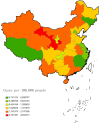Epidemiological trends of hepatitis C incidence and death in Mainland China between 2004 and 2018 and its predictions to 2030
- PMID: 40200162
- PMCID: PMC11980347
- DOI: 10.1186/s12879-025-10881-y
Epidemiological trends of hepatitis C incidence and death in Mainland China between 2004 and 2018 and its predictions to 2030
Abstract
Introduction: This study aimed to evaluate the epidemiological trends and spatial-temporal distribution of hepatitis C virus (HCV) in mainland China.
Methods: HCV monthly incidence surveillance data from 2004 to 2018 was mainly available from the Public Health Sciences Data Center of China. Five models (Bayesian age-period-cohort, BAPC; Auto-regressive integrated moving average, Auto_arima; Exponential smoothing, ETS; Prophet; Earth) were used to forecast the incidence. Temporal-spatial scanning analysis was conducted to visualize the grading of hepatitis C incidence in mainland China.
Results: This study observed 180 months of data from January 2004 and December 2018. A total of 2,278,280 hepatitis C cases and 1771 deaths were reported, with an average annual reported incidence rate of 11.24/100,000. The BAPC model indicated that the indexes (mean absolute error, MAE; mean absolute percentage error, MAPE; mean squared error, MSE; root mean square error, RMSE) in the BAPC model were better than those of the other models (4.33 × 10- 6, 0.03, 2.34 × 10- 11, 4.84 × 10- 6), and annual reported HCV incidence in mainland China would remain at a high level of 17.92/100,000 until 2030. Spatial-temporal aggregation analysis indicated that the time range of the first-class aggregation area was from January 1, 2012 to December 31, 2018, and the aggregation area was in Xinjiang, Qinghai, Gansu, Tibet, Ningxia, Inner Mongolia, Sichuan, Shaanxi, Shanxi, Chongqing, Hebei, Beijing, Henan and Yunnan provinces (relative risk, RR = 2.15, log-likelihood ratio, LLR = 129946.01, P < 0.001).
Conclusions: In summary, this study showed that the incidence of HCV in mainland China continued to be high, and BAPC model suggested that this trend will continue until at least 2030. In order to effectively control the HCV epidemic, it was necessary to strengthen blood safety management, expand screening for high-risk population, improve public awareness of HCV, and provide timely and effective antiviral treatment in potentially high-risk areas.
Keywords: China; Epidemiology; Hepatitis C virus; Incidence.
© 2025. The Author(s).
Conflict of interest statement
Declarations. Ethical approval: It is not necessary for ethical approval in this study. Competing interests: The authors declare no competing interests.
Figures






Similar articles
-
Epidemiological features and spatial-temporal distribution of visceral leishmaniasis in mainland China: a population-based surveillance study from 2004 to 2019.Parasit Vectors. 2021 Oct 7;14(1):517. doi: 10.1186/s13071-021-05002-y. Parasit Vectors. 2021. PMID: 34620225 Free PMC article.
-
Molecular epidemiology of hepatitis C virus genotypes in different geographical regions of Chinese mainland and a phylogenetic analysis.Infect Dis Poverty. 2023 Jul 10;12(1):66. doi: 10.1186/s40249-023-01106-y. Infect Dis Poverty. 2023. PMID: 37430328 Free PMC article.
-
Epidemiological features and sociodemographic factors associated with mumps in mainland China from 2004 to 2018.J Med Virol. 2022 Oct;94(10):4850-4859. doi: 10.1002/jmv.27955. Epub 2022 Jul 9. J Med Virol. 2022. PMID: 35739613 Free PMC article.
-
Enhancing public health surveillance: SARIMAX model incorporating Baidu search index for HCV prediction in China.BMC Med Res Methodol. 2025 Apr 23;25(1):108. doi: 10.1186/s12874-025-02562-w. BMC Med Res Methodol. 2025. PMID: 40269734 Free PMC article.
-
Improving the precision of modeling the incidence of hemorrhagic fever with renal syndrome in mainland China with an ensemble machine learning approach.PLoS One. 2021 Mar 16;16(3):e0248597. doi: 10.1371/journal.pone.0248597. eCollection 2021. PLoS One. 2021. PMID: 33725011 Free PMC article.
References
-
- Collaborators POH. Global change in hepatitis C virus prevalence and cascade of care between 2015 and 2020: a modelling study. Lancet Gastroenterol Hepatol. 2022;7(5):396–415. - PubMed
-
- Guan J, Ren Y, Wang J, Zhu H. The knowledge on HCV: from the discovery to the elimination. Infect Microbes Dis. 2022;4(1):1–6.
-
- Chinese Society of Hepatology; Chinese Society of Infectious Diseases C M A. Guidelines for the prevention and treatment of hepatitis C (2019 version). Zhonghua Gan Zang Bing Za Zhi. 2019;27(12):962–79. - PubMed
MeSH terms
Grants and funding
LinkOut - more resources
Full Text Sources
Medical

